ARCHIVED – Liquefied Natural Gas – A Canadian Perspective – Energy Market Assessment
This page has been archived on the Web
Information identified as archived is provided for reference, research or recordkeeping purposes. It is not subject to the Government of Canada Web Standards and has not been altered or updated since it was archived. Please contact us to request a format other than those available.
Please note that this version includes the changes in the Errata, dated 7 April 2009, which has been added to the Adobe Acrobat report.
Liquefied Natural Gas - A Canadian Perspective - Energy Market Assessment [PDF 2787 KB]
An Energy Market Assessment
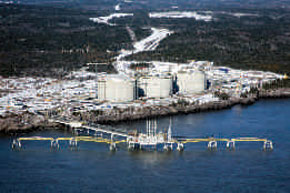

February 2009
Copyright/Permission to Reproduce
Table of Contents
List of Figures
List of Acronyms
List of Units and Conversion Factors
Units
Conversion Factors
Foreword
Executive Summary
Chapter 1 - Introduction
Chapter 2 - Backgroud
2.1 Global Natural Gas Supply and Consumption
2.2 Inter-regional Natural Gas and LNG Trade
2.2.1 East-Asia
2.2.2 Europe
2.2.3 North America
2.3 Outlook on Global LNG Liquefaction and Regasification
2.4 Historical Pricing and Competition for Supply
2.5 Global Influences and Uncertainty
Chapter 3 - North American Natural Gas and LNG Development
3.1 Inter-relationship with Global Markets
3.1.1 Gas Interchangeability
3.1.2 Competition for LNG Supply
3.2 Snapshot of Proposed North American Regasification Development
3.3 North American Influences and Uncertainty
Chapter 4 - Canadian LNG Development
4.1 Current Status of Canadian Projects
4.2 East Coast
4.3 West Coast
4.4 Canadian Issues and Uncertainty
Chapter 5 - Conclusions and Observations
Glossary
Appendices
List of Figures
List of Acronyms
| EIA | U.S. Energy Information Administration |
| EMA | Energy Market Assessment |
| GHG | greenhouse gas |
| IEA | International Energy Agency |
| LNG | liquefied natural gas |
| NEB, the Board | National Energy Board |
| Russia/FSU | Russia and countries of the Former Soviet Union |
| U.K. | United Kingdom |
| USA or U.S. | United States of America |
List of Units and Conversion Factors
Units
| 106m³ | = million cubic metres |
| 106m³/d | = million cubic metres per day |
| 109m³ | = billion cubic metres |
| 109m³/d | = billion cubic metres per day |
| 1012m³ | = trillion cubic metres |
| Bcf | = billion cubic feet |
| Bcf/d | = billion cubic feet per day |
| Btu | = British thermal unit |
| GJ | = gigajoule |
| m³ | = cubic metre |
| mtpa | = million tonnes LNG per year |
| MMBtu | = million British thermal units |
| $ or C$ | = Canadian dollars |
| US$ | = U.S. dollars |
| Tcf | = trillion cubic feet |
Conversion Factors
| 1 m³ gas | = 35.3 cubic feet of natural gas |
| 1 m³ LNG | = 21,824 cubic feet of natural gas |
| 1 Tonne LNG | = 47,257 cubic feet of natural gas |
Foreword
The National Energy Board (the NEB or the Board) is an independent federal agency whose purpose is to promote safety and security, environmental protection, and efficient energy infrastructure and markets in the Canadian public interest[*] within the mandate set by Parliament in the regulation of pipelines, energy development and trade.
The Board's main responsibilities include regulating the construction and operation of interprovincial and international oil and gas pipelines, international power lines, and designated interprovincial power lines. Furthermore, the Board regulates the tolls and tariffs for the pipelines under its jurisdiction. With respect to the specific energy commodities, the Board regulates the export of natural gas, oil, natural gas liquids and electricity, and the import of natural gas. Additionally, the Board regulates oil and gas exploration and development on frontier lands and offshore areas not covered by provincial or federal management agreements.
In an advisory function, the Board also keeps under review and analyzes matters related to its jurisdiction and provides information and advice on aspects of energy supply, transmission and disposition in and outside Canada. In this role, the NEB publishes periodic assessments to inform Canadians on trends, events and issues which may affect Canadian energy markets.
The Board indicated in its 2007 Energy Market Assessment (EMA), Canada's Energy Future: References Case and Scenarios to 2030, that the import of liquefied natural gas (LNG) may play an important role in the future energy supply available to Canadians. Through its scenarios on energy supply and demand for the period 2005 to 2030, the Board provided projections on possible LNG imports into Canada. Although the report indicated that LNG imports could commence in 2009, the scenarios also suggested that there is significant uncertainty with respect to the number of LNG terminals that will be built in Canada, as well as on the amount of LNG that may be imported.
Given that Canada is a relative newcomer in the global LNG market[2], some Canadian natural gas consumers have sought additional information from the NEB that would assist them to better understand the dynamics in the global natural gas and LNG markets. In particular, these parties believe that an independent and objective assessment of global LNG trade would provide valuable insight regarding the likelihood and availability of future LNG imports to North America and on the potential implications to Canadian natural gas markets and LNG development.
[2] Although a number of facilities have existed for many years in Quebec, Ontario, and British Columbia that liquefy pipeline natural gas and store the LNG for later regasification and use during peak demand periods.
This report provides context on the historical global trade of natural gas and LNG and provides an assessment of LNG supply and demand for the period 2008 to 2015. From this analysis, the Board seeks to provide a high-level perspective on the potential implications to LNG development in North America and on the potential effects that imported LNG may have on Canadian gas markets and energy infrastructure.
The scope of this report does not include discussion of the safety and environmental regulations associated with LNG development in Canada which would be subject to the purview of various federal, provincial and municipal agencies depending on the location of the project. For more information, a summary of the regulatory requirements for LNG development in Canada [PDF 147 KB] may be found via the following link on the Board's website.
Any comments on this report or suggestions for further analysis can be directed to:
Margaret Skwara
Market Analyst
Strategy and Analysis
Canada Energy Regulator
Telephone (toll free): 1-800-899-1265
Facsimile: 403-292-5503
Facsimile (toll free): 1-877-288-8803
If a party wishes to rely on material from this report in any regulatory proceeding, it can submit the material as can be done with any public document. In such a case, the material is in effect adopted by the party submitting it and that party could be required to answer questions on it.
Information about the NEB, including its publications, can be found by accessing the Board's website at www.neb-one.gc.ca.
Executive Summary
Canada is a relative newcomer in the global market for liquefied natural gas (LNG). This Energy Market Assessment provides an overview of global LNG supply and demand, trade, and a high-level perspective on LNG development and the potential effects that imported LNG may have on Canadian gas markets and energy infrastructure.
Despite current economic uncertainty, the world requirement for energy and natural gas is projected to grow in the long-term. To meet this increasing requirement, consuming regions are pursuing options to increase gas supply. Options include LNG and pipeline imports, connecting new sources of conventional supply, and developing unconventional resources such as shale gas and coalbed methane.
Global LNG trade enables the development and movement of significant natural gas resources around the world to supplement domestic production and to diversify sources of natural gas in consuming regions. The global LNG market continues to evolve with current prospects for the LNG market quite different than anticipated only a couple of years ago when North American natural gas prices were high relative to the rest of the world and LNG was viewed as a critical incremental source of fuel to parts of North America, including Canada. In 2009, the demand outlook for LNG has been significantly reduced as a result of weak financial and credit markets, slower economic growth, volatile energy prices and the potential for development of other supply options such as pipeline gas imports to Europe and increasing unconventional gas production in North America.
The large amount of regasification capacity currently under construction and proposed to be in-service by 2015 is projected to almost double the world's existing LNG receiving capacity. Availability of supply, full globalization and price convergence in the LNG market is not however expected to keep pace largely because of differences in how LNG prices are determined and the fact that LNG liquefaction facilities require significant lead time for construction.
LNG pricing in major global markets is closely indexed to the price of crude oil or oil products. This is in contrast with North American natural gas prices, which are determined by price competition between various sources of natural gas. LNG price differences affect trading opportunities and the flow of LNG between regions. Europe represents the primary competition to North America regasification terminals for LNG supply.
Despite being the world's largest producer of natural gas, North America has historically required LNG imports to supplement its indigenous production. North America generally acts as a swing market for global LNG largely because of significant capacity for underground natural gas storage. The extent to which North American LNG facilities are used and whether long-term supply is available is determined by a number of additional competitive factors including local, national and global market conditions and demand as well as specific contractual arrangements for supply and markets.
The number of LNG projects to be developed in Canada in the near and long term remains unclear. LNG development in Canada and North America is largely dependent on the outlook for continental natural gas supply and demand. Current economic decline combined with recent increases in U.S. natural gas production from shale and other unconventional gas resources has reduced requirements for near-term LNG imports. The potential size and extent of shale gas resources could significantly displace long-term North American and global LNG requirements.
In general, proposed and existing Canadian LNG projects are located competitively with other North American and global terminals. The first Canadian LNG import terminal (Canaport LNG in Saint John, New Brunswick) is expected to become operational in the first part of 2009. Eastern Canadian import terminal projects are suitably located to serve the important New England market where LNG has historically provided up to 25 per cent of the total natural gas requirement. LNG import terminals on Canada's west coast are not anticipated in the near term because of preference by suppliers to meet Asian demand.
Chapter 1 - Introduction
When natural gas is cooled to a temperature of approximately -160°C (-260°F) at atmospheric pressure, it condenses into a liquid and is reduced to about 1/600th of its volume. This allows large quantities of natural gas to be stored and transported in a more efficient and economic manner[3]. Liquefied natural gas (LNG) has been used as a safe, convenient and effective means to store and transport natural gas around the world for many decades[4].
[3] The LNG value chain is described in Appendix 5.
[4] LNG Safety and Security, Center for Energy Economics (2003).
In North America, commercial operations to liquefy and store natural gas were initiated in the 1940s and the first transatlantic LNG shipment by tanker took place in 1959. The LNG industry was proven in earnest during the 1960s with the United Kingdom (U.K.) importing natural gas from Algeria, after which additional marine liquefaction plants and import terminals were constructed around the world. Operation of the first North American facility to liquefy and export LNG began in Kenai, Alaska in 1969 and the first North American terminal to receive and regasify LNG opened in Everett, Massachusetts in 1971. Since then, numerous LNG receiving terminals have been constructed across North America including the first in Mexico in 2006 and the first in Canada in 2009, located at Saint John, New Brunswick.
Historically, LNG was developed and used primarily as a means to commercialize stranded natural gas resources around the world[5] and the natural gas used as an alternative to crude oil in countries with little or no indigenous oil and gas production. Today, LNG provides an increasingly important source of natural gas to satisfy a growing world demand for energy. In 2007, LNG accounted for over 200 109m³ annually (almost 21 Bcf/d), or about 7.4 per cent of the global natural gas production (Figure 1.1). In comparison, Canada's natural gas production and consumption in 2007 was about 175 109m³ (17 Bcf/d) and 77 109m³ (8 Bcf/d), respectively.
[5] Natural gas resources considered too far from market to be accessed economically by pipeline.
Figure 1.1 - LNG Share of World Natural Gas Market
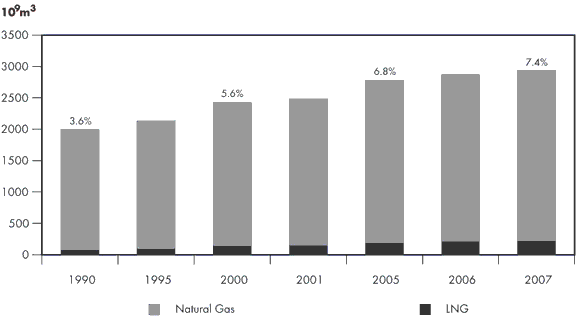
Source: BP Statistical Review of World Energy
As illustrated in Figure 1.2, worldwide natural gas consumption has increased by over 40 per cent since 1990. In the same time, LNG production has approximately tripled. The growth in LNG development has been fueled by the increasing consumption of natural gas, particularly for electricity power generation. Demand for electricity remains strong worldwide and is expected by the U.S. Energy Information Administration (EIA) to account for nearly one-half of the incremental worldwide energy consumption over the period 2005 to 2030[6]. The EIA expects that by 2030, over one-third of worldwide natural gas consumption will be used for electricity generation and that total global natural gas consumption will increase by about 25 per cent, from about 2 940 109m³ (104 Tcf) in 2005, to 3 660 109m³ (129 Tcf) by 2015.
[6] EIA International Energy Outlook, September 2008.
Figure 1.2 - Global Natural Gas Consumption and Outlook
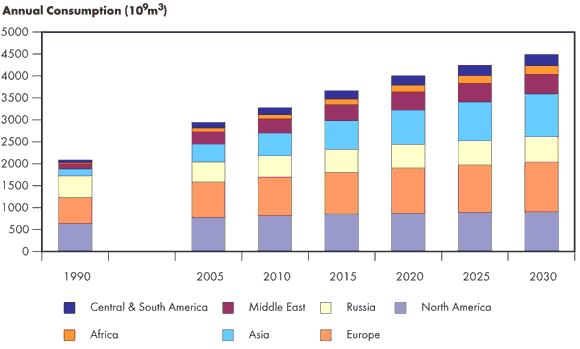
Source: EIA International Energy Outlook 2008
Although the use of natural gas for electricity generation can vary across regions, consumption is generally increasing as countries strive to meet growing energy demand, reduce carbon and other greenhouse gas emissions (GHGs), and phase out the use of older generation facilities.
Meanwhile, natural gas production in the major consuming regions of North America, Europe and Asia has not kept pace with the growth in demand for natural gas (Figure 1.3). In this environment, the inter-regional trade of natural gas by either pipeline or LNG has become the principle means to ensure that reliable and secure energy supplies are available to meet requirements in these regions.
Figure 1.3 - Natural Gas Balance in Major Consuming Markets
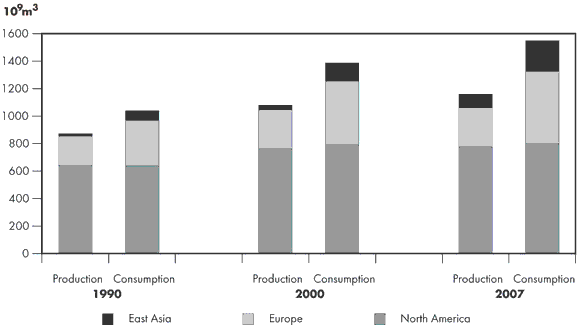
Source: BP Statistical Review of World Energy
The growing dependence on natural gas and competition for LNG in international markets has stimulated growth in LNG projects worldwide.
Potential markets for additional LNG supply are continuing to evolve. Only a few years ago, North American natural gas prices were the highest in the world as indigenous gas production struggled to keep pace with the expected growth in regional demand. This growing reliance on natural gas helped to spawn a number of projects to import LNG into North America. Today, new prospects for indigenous natural gas production from shale and other unconventional sources appear very promising and consumption has waned with a slowdown in the North American economy.
Moreover, Asian and European consumption and prices have increased, drawing away LNG supply once available for North America. Facilities in North America which once contemplated LNG imports are now also considering regulatory authorizations to re-export the imported LNG.
Scope of this Report
As Canada is a potential market for global LNG and a significant consumer of natural gas, this EMA examines ongoing developments in global LNG. Chapter 2 examines the historical development of LNG around the world and provides a high-level perspective and outlook on potential developments in LNG supply and imports.
Next, Chapter 3 examines the recent LNG developments in North America, describes the possible future role of LNG in North America, and provides a perspective on future LNG supply availability.
Chapter 4 provides further discussion on Canadian markets and LNG development. Note that this report does not provide any detailed analysis or opinion on any specific project. Finally, Chapter 5 examines the potential uncertainties and issues with respect to Canadian LNG development and includes a discussion of the possible implications for Canadian gas markets, LNG development, and related NEB regulatory activities.
Chapter 2 - Global LNG and Natural Gas
2.1 Global Natural Gas Supply and Consumption
In simple terms, the increasing development of LNG is viewed as a key means to access worldwide natural gas resources and supply the world's growing requirement for energy and natural gas. Proven reserves of natural gas worldwide are about 20 times larger than the proven reserves in North America and about 10 times larger than the combined proven reserves found in the world's three largest LNG consuming regions (North America, Europe and East-Asia[7]). In 2007, Canada's natural gas reserves were estimated to be about 1.6 1012m³ (58 Tcf), or less than one per cent of worldwide reserves. Estimates for total worldwide natural gas reserves are as high as 178 1012m³ (6 300 Tcf), of which over 70 per cent is located in Russia, the former Soviet Union (FSU), and the Middle East (Figure 2.1).
[7] Includes major consuming countries of Japan, South Korea, China and Taiwan.
Figure 2.1 - Estimated Natural Gas Reserves (2007)

Source: IEA 2008
Figure 2.2 illustrates the relative levels of natural gas production and consumption in various global regions and indicates that the regions which rely heaviest on inter-regional gas imports are Asia and Europe. In North America, the United States and Mexico are also net importers, but as one of the world's largest natural gas producing regions, historical North American LNG imports have been relatively small compared to Asia and Europe.
Figure 2.2 - World Production and Consumption of Natural Gas (2007)
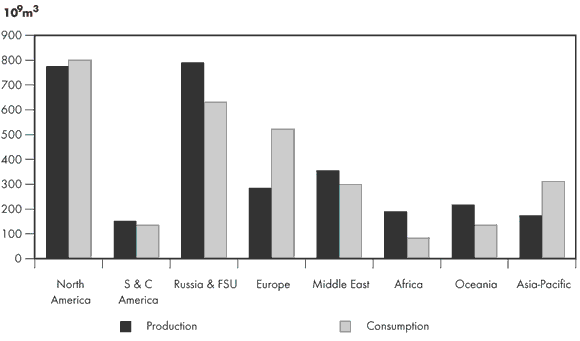
Source: BP Statistical Review of World Energy
In 2007, East-Asia, Europe and North America consumed about 1.6 1012m³ (57 Tcf) of natural gas, or more than half of the world's total natural gas production. In its recent reference case outlook, the EIA has suggested that the combined annual imports into these three regions would increase from about 440 109m³ (16 Tcf) in 2005, to over 600 109m³ (21 Tcf) by 2015, or an increase of about 37 per cent[8]. The outlook also suggested that annual North American natural gas demand will increase by over 60 109m³ (1.8 Tcf) or ten per cent during this period, up to about 840 109m³ (30 Tcf) by 2015. Over the same period, annual natural gas consumption in Europe and East-Asia are projected to increase by about 150 109m³ (5 Tcf) and 88 109m³ (3 Tcf), respectively.
[8] EIA International Energy Outlook, September 2008
The projected increase in natural gas production in the three regions is more moderate, increasing by only about 130 109m³ (3.7 Tcf) or ten per cent over the period 2005 to 2015. As a result, the overall gap between production and consumption within these regions is widening, which suggests an increasing reliance by these regions on external sources of natural gas (Figure 2.3). Although there is a corresponding increase in natural gas production worldwide, the widening gap between natural gas produced and consumed within these regions has been the primary driver in the development of incremental LNG supply and in the growth of inter-regional natural gas trade.
Figure 2.3 - Growing Reliance on Natural Gas Imports
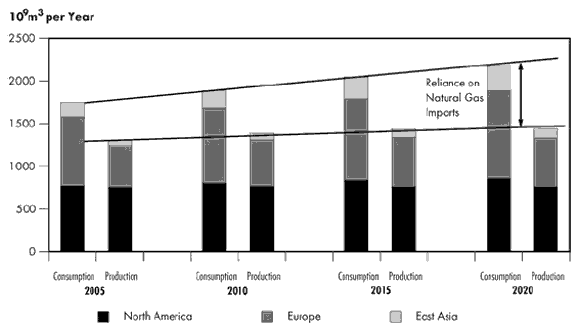
Source: EIA International Energy Outlook 2008
Historically, LNG supply has been developed in countries where natural gas resources far exceeded local requirements and shipping distances to major consuming markets were economically feasible. Continued advances in LNG production[9] and transportation technology are now extending LNG development into other more distant regions as cost-competitive sources of gas supply. The Middle East has emerged in recent years as a major LNG supply region, augmenting traditional supply from the Asia-Pacific region and Africa (Figure 2.4). In addition to the Middle East, significant new LNG liquefaction or production facilities are also being developed in Russia and are expected to begin LNG deliveries by early 2009.
[9] The production of LNG from natural gas is also referred to as liquefaction.
Figure 2.4 - World LNG Production
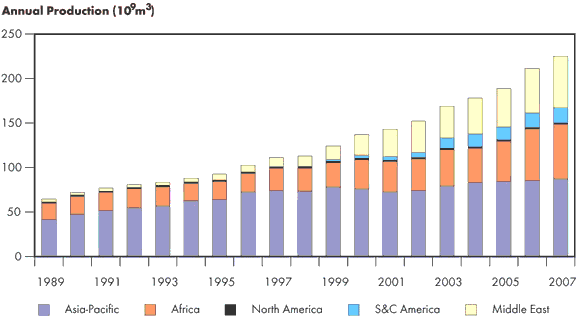
Source: BP Statistical Review of World Energy
The number of new liquefaction facilities currently under construction highlights the growing importance of these new supply sources in the global LNG market. Based on capacity that currently exists or is under construction, the Middle East and Russia are projected to account for up to about 150 109m³ (5 Tcf) of annual LNG output by 2015, or up to 38 per cent of total world LNG production. In 2007, total world LNG production was about 225 109m³ (8 Tcf), about one-quarter of which was produced in the Middle East. By 2015, the Middle East may supply over one-third of world LNG with another three per cent coming from Russia/FSU. For comparison, in 1990 only four per cent of world LNG was produced in the Middle East and almost 95 per cent of global LNG was produced in Africa and the Asia-Pacific region encompassed by Oceania.
2.2 Inter-regional Natural Gas and LNG Trade
The global LNG trade amongst regions in 2007 is shown in Figure 2.5, which illustrates the production, consumption, LNG exports and flows of natural gas by pipeline and LNG into the consuming regions. The figure provides a perspective on the relative scale of operation within the different regions and the dependency of various regions on domestic production, pipeline imports and LNG. The historical LNG volumes imported into the various global regions are shown in Figure 2.6 and provides a perspective on the relative size of the various LNG consuming markets. The key characteristics of the major LNG consuming markets are reviewed in the following sections.
Figure 2.5 - Major LNG Producing and Consuming Regions (2007) - 109m³
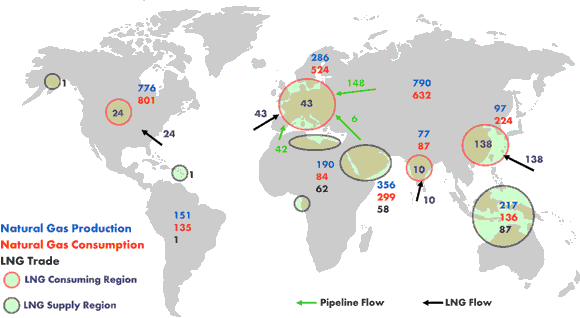
Source: BP Statistical Review of World Energy
Figure 2.6 - World LNG Markets
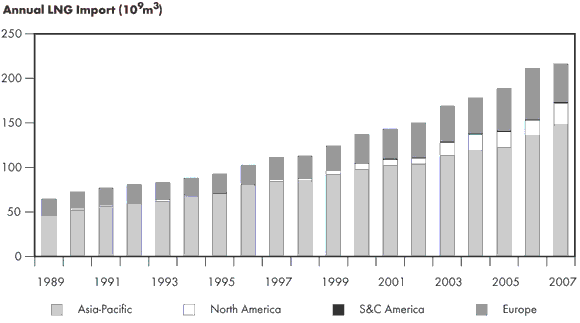
Source: BP Statistical Review of World Energy
2.2.1 East-Asia
Although the East-Asia region accounts for less than ten per cent of world natural gas consumption, the region is by far the largest market for LNG, accounting for almost two-thirds of global LNG consumption and includes the world's two largest consumers of LNG, Japan and South Korea. Combined with India, the general region consumed almost 70 per cent of the world LNG supply in 2007. Without significant oil and gas production and having no access to natural gas via pipeline, consuming countries in East-Asia have relied on LNG from nearby Pacific Rim countries for the majority of their natural gas supply (Figure 2.7).
Figure 2.7 - East-Asia Natural Gas Balance
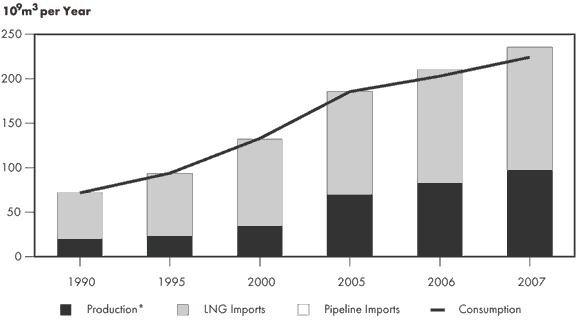
* Predominately From China
Source: BP Statistical Review of World Energy
In East-Asia, electricity generation accounts for the largest portion of natural gas consumption, at almost 45 per cent of the region's total natural gas usage. In Japan, the share used for electricity generation is even greater and has been as high as 65 per cent in recent years. After electricity generation, much of the remaining gas is consumed in the residential, commercial and industrial sectors, in roughly equal proportions.
Given the weather-sensitive nature of natural gas consumption in this region for electricity generation and for residential and commercial heating demand, the quantity of LNG imports is largely seasonal and is very dependent on the amount of electricity that can be generated from alternative fuels (e.g., nuclear, oil, coal). With minimal gas production or pipeline options in this region, the main competing fuel source to natural gas is crude oil or oil products. For this reason, the purchase price of LNG in Asian markets is commonly linked to the average price of crude oil or sometimes to oil products. The region also has little capacity for underground natural gas storage. Consequently, the region relies mainly on LNG storage in aboveground tanks and variable LNG import levels to manage and balance significant fluctuations in demand (Figure 2.8).
Figure 2.8 - East-Asia Seasonal LNG Requirement
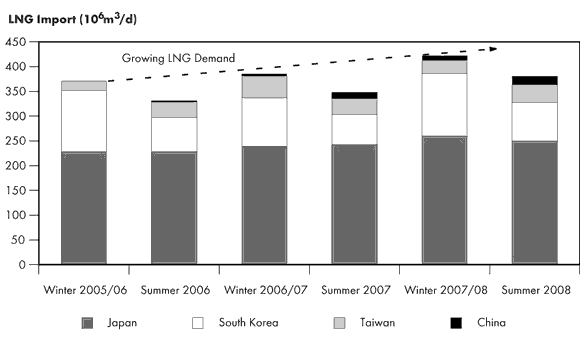
Source: Various data sources
In 2007, Japan imported close to 90 109m³ (3.1 Tcf) of LNG, and South Korea imported almost 35 109m³ (1.1 Tcf) of LNG. Although there has been significant growth during the last decade in other Asian markets such as Taiwan, China and India, Japan alone still represents over 40 per cent of global LNG consumption and about 60 per cent of the Asian LNG market. South Korea accounts for another 16 per cent of global LNG consumption and over 23 per cent of the Asian LNG market. The historical LNG imports into Japan are shown in Figure 2.9, which illustrates Japan's growing LNG requirement and its outreach to non-traditional supply sources in the Atlantic Basin.
Figure 2.9 - LNG Supply to Japan
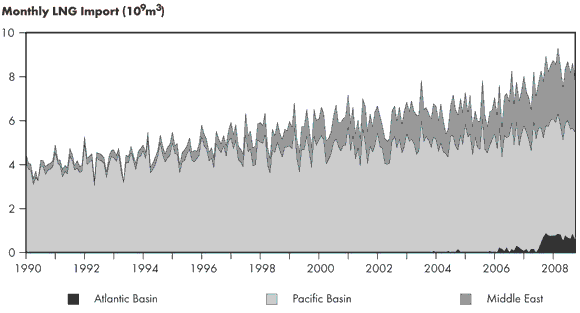
Source: Japan Ministry of Finance
The chart also illustrates the impact of the July 2007 closure of Japan's largest nuclear electricity generation plant on its overall LNG requirement[10]. Following closure of the nuclear plant, Japan's LNG imports increased by more than six per cent. During the winter months when demand is typically greatest, Japan's monthly LNG imports were up by more than one 109m³ (30 Bcf) over the previous winter. To meet this requirement, the higher-priced Japanese market attracted incremental LNG supply from the Atlantic Basin, including sources from as far away as Trinidad and Tobago.
[10] Japan's largest nuclear reactor, the 8.2-Megawatt Kashiwazaki Kariwa nuclear reactor was closed for repairs following a major earthquake on July 16, 2007. Current plans expect the plant to return to service in mid-2009.
LNG demand in the East-Asia region is expected to increase as electricity demand continues to grow and as countries seek to replace generation from other energy sources. New LNG consuming countries are also emerging as countries like Thailand and Indonesia look to LNG imports to meet their own growing requirements for natural gas and electricity (Figure 2.10).
Figure 2.10 - Natural Gas Production and Consumption in Major East-Asian Countries*
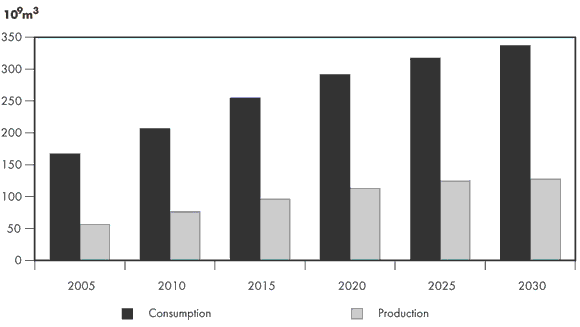
* Includes Japan, South Korea and China
Source: EIA International Energy Outlook 2008, September 2008
2.2.2 Europe
After East-Asia, Europe is the second-largest market for LNG. In Europe, about one-third of total natural gas consumption is used for the generation of electricity and LNG provides an alternative energy source to imported crude oil and pipeline imports of natural gas.
In 2007, about one-half of Europe's natural gas requirements were met by regional production, with the majority obtained from only a few countries (Figure 2.11). Incremental supply from new sources in Northern Europe, such as the North Sea sectors of Norway and Denmark, has helped to increase regional production and serve a growing demand for natural gas. However, in recent years those additions have not been able to offset an overall decline in European production. As a result, a growing share of the European requirement for natural gas is now being met through imports of LNG or by pipeline from Russia, countries of the FSU, and Africa (Figure 2.12).
Figure 2.11 - European Natural Gas Production
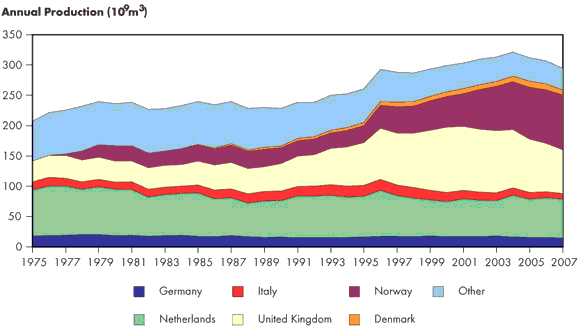
Source: BP Statistical Review of World Energy
Figure 2.12 - European Natural Gas Balance
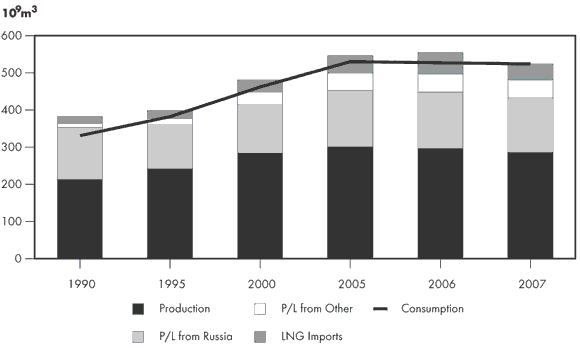
Source: BP Statistical Review of World Energy
European LNG imports have historically attracted supplies from Africa and other Atlantic Basin suppliers. Although on average LNG accounts for less than ten per cent of Europe's total gas supply today, the International Energy Agency (IEA) projects that by 2015 LNG may provide up to 140 109m³ (5 Tcf), or 15 per cent of the annual European gas requirement[11].
[10] IEA Natural Gas Market Review 2008
The increased use of LNG may also help some European countries to diversify sources for natural gas supply and reduce reliance on any particular supplier. However, LNG import terminals are currently concentrated in only a few countries. With declining regional production, other European countries without LNG are faced with a growing reliance on pipeline supplies from Russia and the FSU. LNG development is seen as an option by European countries to increase security of natural gas supply and avoid over-dependence on any single source of natural gas.
While natural gas production and pipeline imports are readily accessible in many parts of Europe, in some countries such as Spain, the natural gas infrastructure is not well-integrated with the continental pipeline grid and imported LNG accounts for a much larger portion of supply. Similarly, the availability of natural gas storage is not evenly distributed, further limiting the volume of LNG imports in many regions to only the volume that may be readily consumed.
In Spain, LNG provides over two-thirds of annual natural gas requirements. While Spain's natural gas requirement (35 109m³ or 1.2 Tcf in 2007) represents less than 10 per cent of Europe's total gas consumption, Spain's LNG imports (24 109m³ or 0.9 Tcf in 2007) account for over half of total European LNG imports. This highlights the major role and influence that Spain has in the European and Atlantic Basin LNG markets.
Although some parts of Europe such as the U.K. may enjoy a diverse supply of natural gas and have evolved toward competitive market prices that are determined based on competing sources of gas supply, natural gas prices are still largely influenced by other markets in continental Europe that compete for the same gas supply. Consequently, European natural gas prices are influenced by the long-term contracts for natural gas imports into the region by pipeline and LNG. In these contracts, prices are often determined based on the cost to obtain an equivalent value of energy from an alternate fuel available in each country and are typically linked to the price of oil products or sometimes to crude oil.
The demand for natural gas and LNG in Europe is also largely dependent on weather, particularly with limited gas storage in consuming regions and about two-thirds of natural gas consumption being used for electricity generation or heating in the residential and commercial sectors.
Future LNG demand in Europe is expected to increase as electricity demand continues to grow. Demand for LNG will also extend into eastern Europe, as new countries pursue LNG as a means to meet their own growing requirements and improve energy security by reducing dependence on pipeline imports from Russia and the FSU. In addition to development of LNG import projects, there are also several pipeline projects from Africa and Russia and the FSU being developed or proposed to supply Europe's growing natural gas requirements.
2.2.3 North America
Although LNG import facilities have existed in North America since 1971, North America has not been a major importer of LNG. Until about 2003, LNG import volumes typically provided less than one per cent of total North American natural gas requirements. The bulk of those total requirements are met through growth in natural gas production and the associated expansion of pipeline infrastructure (Figure 2.13). LNG in this environment was primarily used to supplement domestic production and as a means to ensure security during peak demand periods, most notably in the U.S. northeast where natural gas production and pipeline infrastructure are more limited.
Figure 2.13 - North American Natural Gas Balance
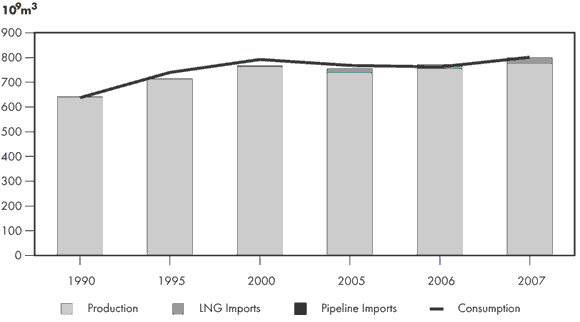
Source: BP Statistical Review of World Energy
Being a relatively small player in the global LNG market and having an abundance of regional production, North American LNG imports have typically been limited to the nearest suppliers in the Atlantic Basin, (i.e., from Trinidad and Tobago and North Africa). Historically, North American LNG receiving terminals were located only in the U.S. In 2006, Mexico brought its first LNG receiving terminal into service on the east coast and added a second terminal in Baja California in 2008. Moreover, other terminals are currently being constructed in Atlantic Canada and on Mexico's west coast.
In 2007, North American LNG imports totaled about 24 109m³ (850 Bcf), with over 90 per cent of that volume delivered into the U.S. and the remainder into Mexico. The U.S. also exports an average of 1.6 109m³ (60 Bcf) of LNG each year to Japan from its liquefaction facility in Kenai, Alaska.
Given prospects for growing natural gas demand amidst a backdrop of a less than certain outlook for future natural gas production, North America had experienced renewed interest in LNG imports in recent years. Concerns about environmental consequences from combustion of fossil fuels and a projected decline in natural gas production from some traditional sources (e.g., conventional natural gas production in Canada) have fueled expectations of an increasing requirement for LNG imports. This has led to the construction of numerous new facilities to import LNG into North America and a diversification of LNG suppliers in recent years. At the end of 2008, North American LNG regasification capacity is estimated to be over 400 106m³/d (14.5 Bcf/d), over half of which is located in the Gulf of Mexico region.
With over one-half of total North American gas consumption used for space heating and cooling, demand is very weather-dependent and can vary substantially on a seasonal basis. While weather may influence the amount of LNG consumed in North America, an increasingly and perhaps greater influence on the level of North American LNG imports is the availability of LNG after accounting for requirements in other global markets. This is particularly the case as other global markets may have more limited indigenous gas production and natural gas storage options.
Figure 2.14 illustrates the dynamics and relationship of other global markets to North American LNG imports and the swing market characteristic of the North American LNG market. This was particularly evident during the summer of 2007, when mild weather and low demand resulted in low LNG prices in Europe, while gas demand and prices were high in North America. As a result, suppliers made significantly larger deliveries of LNG to North America and were able to obtain relatively higher prices and earn greater returns after deduction of transportation costs. Consequently, North America imported LNG at record-high levels during the first half of 2007, with much of the gas used to replenish storage inventory levels that were drawn down because of cold weather during the previous winter.
Figure 2.14 - World Market Influence on U.S. LNG Imports
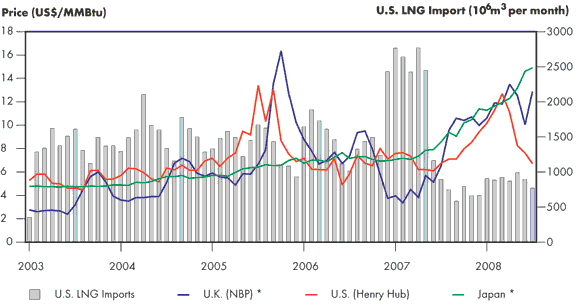
* Converted to US$/MMBtu from data derived from the InterContinental Exchange (ICE) and the Japan Ministry of Finance
Since mid-2007, LNG demand and prices in Asia and Europe have been higher than in North America which has reduced the amount of LNG supply directed to North America. The regional allocation of LNG deliveries intensified with the unplanned outage of Japan's largest nuclear electricity generation facility following a major earthquake in July 2007. Since then, Japan's LNG requirements have increased, drawing up to one 109m³ per month (one Bcf/d) of LNG supply from the Atlantic Basin. Crude oil and related product prices have also increased strongly during this period, which resulted in much higher LNG prices in Asia and Europe. The strong demand and prices in Asia and Europe have persisted into 2008, as the Japanese nuclear plant remained offline and European natural gas consumption was high because of lower electricity generation from coal and dry weather reduced the availability of hydro-electricity.
Consequently, North American LNG imports in 2008 remain lower than historical levels despite the recent construction of several new import terminals. In recent months, there has been significant growth in U.S. natural gas production, particularly from tight sand and shale gas resources which has offset much of the immediate requirement for LNG imports. Although the full extent of new gas supply from these unconventional sources is not definitive, the recent optimistic outlook on incremental production and the decline in natural gas demand have created uncertainty for LNG imports.
With the waning need for immediate LNG imports, two of the recently constructed receiving terminals have applied for U.S. regulatory approval to re-export imported LNG[12]. With relatively minor facility modifications, imported LNG could be received and stored at the terminal until a market develops either in the U.S. or abroad. Re-export would enable facilities to be kept operational[13] amidst a competitive LNG market, while most of the LNG may be re-shipped to other markets. Also, given the potential for further growth in U.S. production and the prospective development of shale and tight gas resources in Canada, there is now a proposal to construct an LNG liquefaction and export terminal in northwest British Columbia.
[12] Freeport LNG and Sabine Pass LNG
[13] Once operational, it is generally desirable to maintain the LNG-handling facilities at a constant low temperature.
2.3 Outlook on Global LNG Liquefaction and Regasification[14]
Although there has been development of additional LNG supply around the world, the pace of development for new liquefaction capacity has varied across regions and is significantly less than additions to regasification capacity (Figure 2.15 and Figure 2.16). Major LNG markets in Asia and Europe are seasonal in nature, often have only limited storage, and consequently require regasification capacity that is designed to meet peak market requirements. For that reason, those facilities may not always operate at high utilization levels. On the other hand, the longer lead time and higher costs associated with upstream development and liquefaction facilities generally require larger projects for economy of scale with high and stable utilization rates. Having access to regasification capacity to service different markets in excess of liquefaction capacity facilitates a high utilization of the more expensive liquefaction assets. This also allows suppliers to capitalize on arbitrage opportunities to optimize returns.
[14] See Appendix 2 and Appendix 3 for a summary of global liquefaction and regasification capacity.
Figure 2.15 - Global LNG Liquefaction and Regasification Outlook
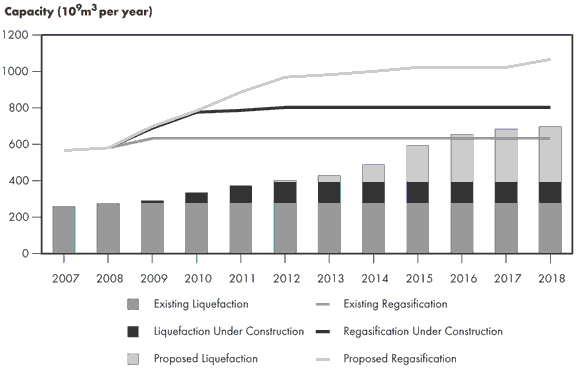
Figure 2.16 - Global LNG Liquefaction Under Construction
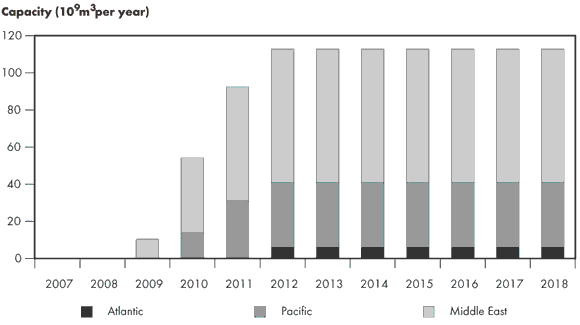
Historically, liquefaction and regasification projects have been developed in close alignment, often with some common stakeholders, rigid long-term contracts, and dedicated shipping vessels that linked the supply to specific markets. Spare shipping capacity was limited and diversion of LNG supply to alternate markets would usually occur only during periods of low demand in the primary market, as the re-routing of tankers would temporarily reduce the ability to serve the primary market.
Associated with the significant growth in worldwide LNG development during the past decade, the LNG industry has also increased its capacity to serve multiple markets and engage in shorter-term trade. In recent years, particularly with strong demand and higher prices during peak demand periods, new LNG developers now commonly hold a certain portion of liquefaction output for short-term trading opportunities. Often these developers use their own trading affiliates to manage a portfolio of LNG supply to serve a number of potential markets through more flexible contracts. Short-term LNG trade has provided suppliers with greater opportunity to capture higher prices among multiple competing markets, thereby maximizing returns and use of infrastructure.
The LNG shipping fleet has also grown substantially, almost tripling the number of ships and capacity in the last decade (Figure 2.17). The size of new LNG tankers is also larger than ever. With greater shipping distances, the use of larger cargoes provides an economy of scale which reduces the per unit transportation costs of LNG. The expansion of the LNG shipping fleet has also provided suppliers with greater flexibility to serve multiple markets, which has supported the growth of inter-basin trading and enabled greater liquidity within the LNG market.
Figure 2.17 - LNG Shipping Fleet
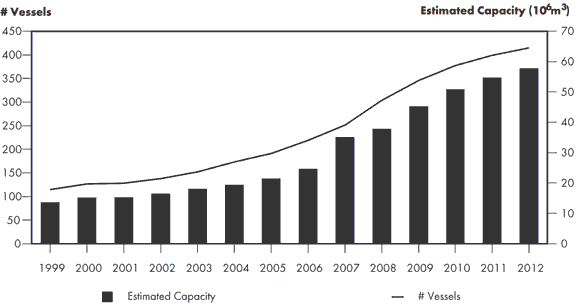
Source: Argus and NEB estimates
LNG markets have developed regionally in two basins: the Atlantic Basin, which includes Europe and eastern North America; and the Asia-Pacific Basin, which consists of East-Asia, Oceania, and western North America. While traditional sales agreements consisted mostly of intra-basin trade arrangements, as the LNG market has grown, the increased competition for LNG supply has resulted in higher prices and greater globalization of LNG trade. This has improved the economics and provided the impetus for large-scale upstream development in new regions such as Qatar.
Figures 2.18 and 2.19 provide a snapshot of the projected liquefaction and regasification development in the Atlantic and Asia-Pacific Basins over the next decade. Regasification capacity that is currently under construction and expected to be in-service by 2015 will more than double the total existing LNG receiving capacity in world markets. The majority of new regasification capacity is expected to be added in the Atlantic Basin. World liquefaction, however, takes much longer to develop and is expected to increase by about 110 106m³/d (5 Bcf/d) during this period. Although many more liquefaction projects have been proposed, it is unlikely that all will proceed and those that do may take longer to develop.
Figure 2.18 - Atlantic Basin LNG Development
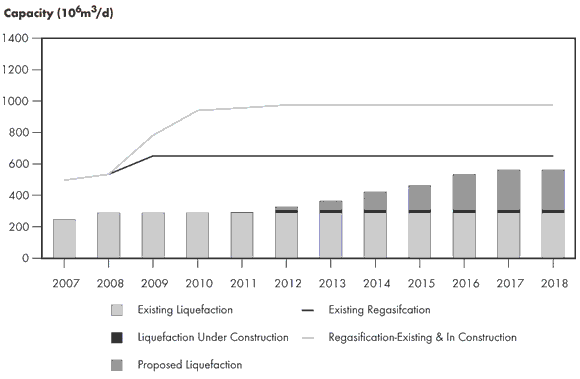
Figure 2.19 - Asia-Pacific Basin LNG Development
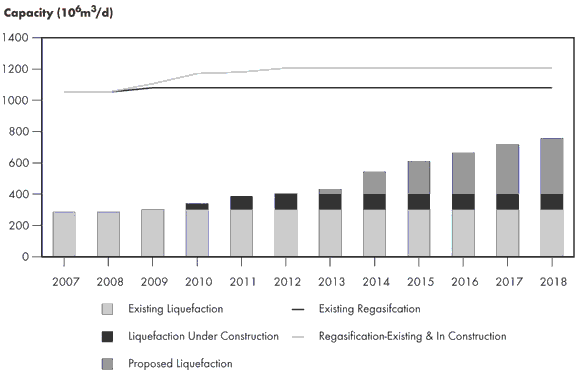
Consequently, the LNG market is expected to remain fairly competitive until after 2015. Figure 2.20 indicates that it is around that time, that the proposed development of significant additional LNG liquefaction in the Middle East could be brought into service.
Figure 2.20 - Middle East LNG Liquefaction
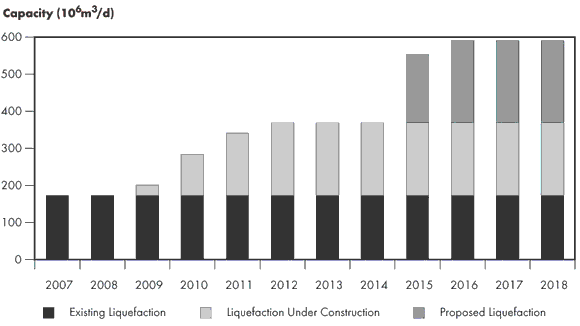
2.4 Historical Pricing and Competition for Supply
Incremental supply development from new regions, such as those in the Middle East and Russia, are more distant from market than historical suppliers. However, aided by advances in LNG shipping technology and economy of scale savings through the use of much larger tankers, economic development of these supplies is being made possible. Moreover, these regions are also situated centrally to the major LNG consuming markets in both the Atlantic and Asia-Pacific Basins, thereby providing multiple market options and arbitrage opportunities to achieve the highest return.
Hence, a growing portion of LNG supply is able to cost-effectively serve both Atlantic and Asia-Pacific Basin markets on a routine basis. This will mean greater inter-basin trade and may also help to connect LNG prices in Atlantic and Asia-Pacific markets. In the Natural Gas Market Review (2008), the IEA suggests that inter-regional trade will increase from about 13 per cent in 2005 to about 17 per cent by 2015 and will aid further globalization of the natural gas market. Even so, price convergence with the North American natural gas market, if the proper conditions are achieved, will likely take additional time given the low quantities of LNG being consumed in North America. Unlike other global markets, North American prices are not directly linked in sales contracts to the price of crude oil or oil products. The abundance of indigenous natural gas production allows North American natural gas prices to be determined based primarily on the supply and demand of natural gas within the continent. The use of extensive underground natural gas storage capacity also allows North America to act as a swing market that can import larger quantities of LNG during periods when demand and prices are lower in Asia and Europe.
2.5 Global Influences and Uncertainty
The large amount of new regasification capacity being added in North America, Europe and East-Asia is likely to maintain competition for global LNG supply. However, the amount of LNG required in each specific market is uncertain given the potential for further development of other supply options such as pipeline gas imports into Europe and unconventional gas production in North America. Moreover, the outlook for gas demand is uncertain, given the weather-sensitive loads being served and the difficulties in the global credit and financial markets experienced in 2008. Economic slowdown in key consuming markets will likely reduce overall natural gas demand in the near term. The related drop in global crude oil prices will also impact LNG supply development, given the oil-indexed pricing structure in long-term supply contracts. However, in the longer term, economic recovery and environmental initiatives to reduce the combustion of other fossil fuels and GHG emissions are likely to result in significant demand for natural gas and LNG.
Growth in LNG liquefaction and supply, particularly with the significant addition of supply from the Middle East, will increase the prevalence of shorter-term contracts with flexible market arrangements. These in turn, will enable greater international trade of LNG and are likely to increase the availability of supply to swing markets such as North America, particularly during periods when demand is lower in Europe or East-Asia.
The large investments and long lead time associated with LNG development limits participation in projects to relatively few larger, multi-national or government-sponsored corporations capable of funding these endeavours. Due to limited number of participants in a highly competitive market, there will be reluctance by parties to reveal specific information on markets and pricing in order to make a swap or other trade arrangement with other suppliers. The physical compatibility of the LNG vessel or of the LNG composition (gas quality) to a specific market destination may limit international trade.
The uncertainty in financial markets and tighter credit requirements experienced in 2008 may impose additional requirements on new LNG development and limit the participation of new entrants. In general, new project financing may require a greater equity contribution from developers than in the past, in addition to having solid financial backing and commercial arrangements. It is not clear whether there may be additional requirements for liquefaction plant developers to tie a greater portion of project output to long-term contracts, particularly as participants can significantly benefit from short-term arbitrage opportunities.
Chapter 3 - North American Natural Gas and LNG Development
Despite being one of the world's largest producers of natural gas, in the last decade imports of LNG to North America have increased to supplement indigenous production. Recent projections by the EIA suggest there will be a growing gap between natural gas production and consumption in North America, despite an expected gain in U.S. natural gas production.
The EIA estimates that the deficit between North American natural gas consumption and natural gas supply will continue to increase in the period to 2020 (Figure 3.1)[15]. Although U.S. natural gas production is projected to increase by over 123 106m³/d (4 Bcf/d) from 2005 levels, Canadian natural gas production is expected to decrease and overall North American natural gas consumption is projected to increase by about 250 106m³/d (9 Bcf/d)[16].
[15] EIA International Energy Outlook 2008
[16] Most recent projections for the U.S. natural gas production from the EIA Annual Energy Outlook (early release, December 2008) expects U.S. natural gas production in 2020 to be 228 106m³/d (8 Bcf/d), higher than 2005 levels.
Figure 3.1 - North American Natural Gas Consumption and LNG Imports
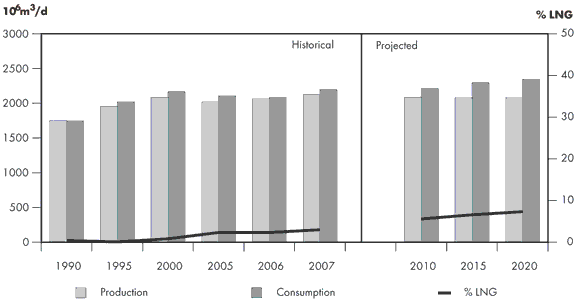
Sources: Historical from BP, Projection from EIA International Outlook 2008 with adjustment from 2009 Annual Energy Outlook
Although these projections may not incorporate the full effects of the 2008 economic slowdown and uncertainty in financial markets, it is likely that the projections for both demand growth and supply addition may be less than originally expected. The projections also do not account for any possible environmental policies that may promote natural gas use in favour of other fossil fuels in electricity generation as some have suggested.
A large part of the popularity of gas-fired generation particularly in the near term is driven by the reduced environmental impact of using natural gas relative to other fossil fuels and the increased efficiency, relatively shorter lead time to build, and low capital costs associated with the use of gas-fired power generation plants.
Continental Natural Gas Supply and Demand
Despite recent progress and significant additions from production of unconventional natural gas resources such as shale and coalbed methane, projections for future natural gas consumption suggest that there will be a need for additional sources of gas supply, including a requirement for LNG imports. The EIA projections suggest that LNG imports could increase from about 65 106m³/d (2.3 Bcf/d) in 2007 to over 150 106m³/d (5 Bcf/d) by 2020 and provide over five per cent of North America's total natural gas requirement.
In this environment, LNG provides an important source of gas to balance supply and demand. This is true particularly during the winter months in the New England region, where LNG has historically provided up to 25 per cent of the total natural gas requirement. Having little gas production within the region and limited pipeline access to other North American supply, the New England market is the market in North America that is most dependent on LNG.
Natural Gas Production
The extent to which other sources of natural gas can be developed and connected to markets will influence the future requirement for LNG in North America.
Most recently, gas production from shale resources in the U.S. have been significant and have helped to offset declines from other conventional sources. Although shale resources have historically not been significant prospects for gas production, recent advances in horizontal drilling and the use of induced hydraulic fractures have now enabled economic development. Most significantly, the Barnett Shale in Texas is now being extensively developed after having only limited success in previous decades.
With the prevalence of other shale deposits across North America, there has been much optimism and an increase in recent industry activity to pursue potential development of these resources. In Canada, efforts are ongoing to assess shale prospects in northeast B.C. (Horn River Basin and the Montney formation), southern Alberta and Saskatchewan (Colorado shale), Quebec (Utica shale), and Atlantic Canada (Windsor Group shales).
While having significant potential, the full extent of commercial development of shale resources is yet uncertain. The near-term contribution of Canadian shale development may also be constrained by the need to assess viability, optimize operations, and build the necessary connecting infrastructure to access major pipelines.
3.1 Inter-relationship with Global Markets
Increasing LNG imports are likely to further connect North American natural gas markets to the world market. However, the relatively small volumes and the seasonal nature of North American imports may not be sufficient to create price convergence and result in common LNG pricing in a single global market. In the current market environment, North American LNG imports are likely to occur under flexible destination and shorter-term contracts. This would particularly apply to off-season LNG imports.
Relative to other major gas consuming regions (i.e. East-Asia and Europe), an abundance of natural gas storage capacity and substantial LNG receiving and regasification capacity provides North America with the ability to import large quantities of LNG during the off-season (i.e. summer) when LNG demand is typically lower in other northern hemisphere markets.
Figure 3.2 illustrates the historical sources of LNG imports into the U.S. While LNG from Algeria has been the longest-serving supplier, Trinidad and Tobago is the closest to east coast terminals and has provided almost two-thirds of recent North American LNG imports. In recent years, difficulty in further expanding LNG production from Trinidad and Tobago has resulted in a larger share of North American imports coming from new and more distant sources in Africa and the Middle East.
Figure 3.2 - U.S. LNG Imports
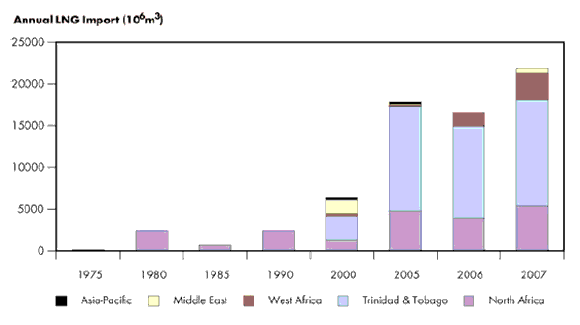
Source: U.S. Department of Energy
To these new LNG suppliers, the North American market may not be the most proximate and may entail longer shipping times and higher transportation costs. However, having the flexibility to serve North American markets is an important option, either to:
- obtain higher returns when demand and prices are higher in North America (such as in 2005 after hurricane-induced production disruptions); or,
- secure a ready market that can absorb LNG deliveries when demand is lower and the LNG is not required in other markets. As an alternate market, North American natural gas prices can be an important lower benchmark for global LNG prices.
3.1.1 Gas Interchangeability
The projected growth in LNG imports and the greater diversification of LNG supply are likely to entail additional challenges for LNG importers and connecting pipelines to ensure the compatibility or interchangeability of regasified LNG with traditional gas supply. Historically, the majority of North American LNG imports have originated from Trinidad and Tobago or Algeria as regasified LNG from these suppliers have composition and burning qualities similar to traditional pipeline gas. For LNG with significantly different qualities, imports may be more limited because of a need to blend these volumes with other gas supplies to facilitate the seamless use of LNG in the regional market.
This issue is particularly important where LNG is imported directly into consuming regions. Such imports can provide significant benefits by increasing the availability of gas, diversifying sources of supply, easing pipeline bottlenecks and reducing transportation costs. However, there may be additional challenges and costs associated with enabling end-use equipment to use natural gas with more variable composition. For markets with newer power generation facilities and other specialized equipment designed to use a narrow range of gas composition, further blending or processing may also be required to make the combustion characteristics of the regasified LNG similar to that of traditional gas supply.
Although potential differences in gas composition may exist across all sources of gas supply, including domestic production, the opportunity to blend or process a particular gas stream can be much greater in a producing region, such as the Gulf of Mexico, which has an abundance of pipelines and processing infrastructure. Consequently, gas interchangeability is an important consideration for LNG terminal developers with respect to site selection, process design, and the source and quantity of LNG contemplated for import.
Appendix 4 illustrates the heat content of LNG from various supply regions of the world. Although heat content is only one indicator of gas quality and interchangeability, it serves to provide a perspective of the wide variability of LNG. In general, LNG markets in East-Asia are able to accept LNG with heavier hydrocarbons and much higher heat content than markets in Europe and North America. Consequently, LNG from sources in the Asia-Pacific Basin generally will have higher heat content than most supply from the Atlantic Basin.
3.1.2 Competition for LNG Supply
For terminals in eastern North America, Europe represents the main competition for Atlantic Basin LNG supply. As illustrated by Figure 3.3 and Figure 3.4, both Europe and North America are large consumers of natural gas and both markets are projected to require significant imports in order to meet future gas requirements.
Figure 3.3 - Natural Gas Production and Consumption in North America

Sources: EIA International Energy Outlook 2008 and Annual Energy Outlook 2009
Figure 3.4 - Natural Gas Production and Consumption in Europe
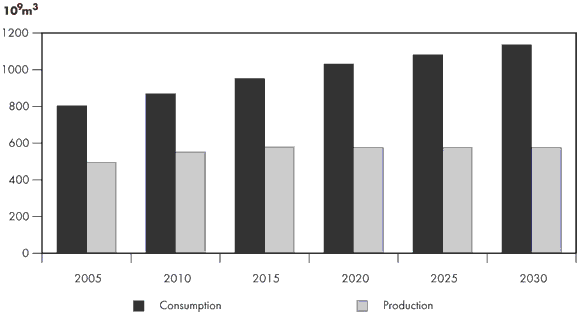
Source: EIA International Energy Outlook 2008
The competitive relationship between North America and Europe for Atlantic Basin natural gas supplies in recent years is illustrated in Figure 3.5. In general, North American LNG imports are highest during the summer periods when European natural gas demand and prices are lower. In winter, when prices and demand are usually higher in Europe, North American import volumes can be significantly lower.
Figure 3.5 - U.S. LNG Imports and Atlantic Basin Competition
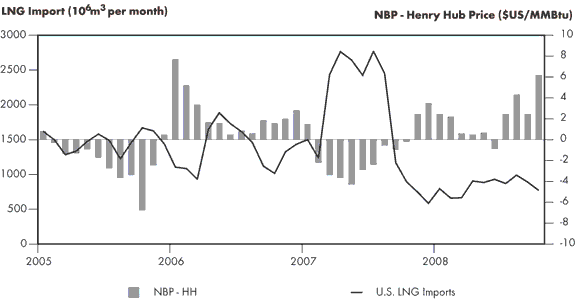
Sources: Intercontinental Exchange, U.S. Department of Energy
The recent development of new LNG markets in the southern hemisphere could potentially offer significant competition to summer LNG imports into North America. In 2008, Argentina and Brazil inaugurated South America's first LNG import terminals and there are proposals for a number of other projects in countries such as Argentina, Brazil, El Salvador and Uruguay that are in various stages of development. If developed, these projects could reduce the amount of LNG that may be available to North America.
3.2 Snapshot of Proposed North American Regasification Development
Since 2005, in addition to reactivation and expansion of existing regasification facilities, more than two dozen new LNG receiving and regasification terminals have been approved for construction in North America. Of these, four new terminals have been built and another six terminals are currently under construction. The magnitude of this additional capacity in eastern North America compared to the total projected liquefaction capacity or supply available in the Atlantic Basin is illustrated in Figure 3.6.
Figure 3.6 - Atlantic Basin LNG Supply and North American Imports
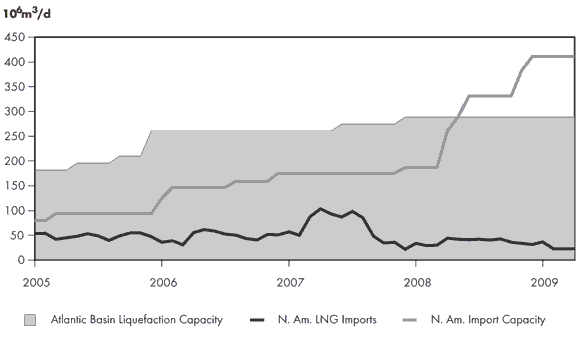
Source: NEB estimates
This comparison suggests that even without any additional regasification projects beyond those already existing or under construction (from a volumetric perspective), the capacity for North American terminals to receive LNG already exceeds the total capacity to produce LNG in the Atlantic Basin. Combined with similar trends in European regasification capacity, and for East-Asian markets in the Asia-Pacific Basin, a highly competitive environment for LNG supply is expected to continue, at least until significant new supplies from production or imports can be developed.
The comparison also suggests that available LNG supply in the immediate market area may not be sufficient to satisfy potential market growth or that much of the regasification capacity may not be fully utilized. Moreover, there is likely to be significant competition between markets in both the Atlantic and Asia-Pacific Basins for additional supply from more distant sources such as the Middle East, which are suitably located to engage in inter-basin trade.
The extent to which long-term LNG supply will be available to North American LNG facilities on a regular basis will largely be determined by market conditions and by the stakeholders involved and their ability to develop and contract LNG worldwide. LNG suppliers have the flexibility to serve various markets and may select markets to maximize return on investment and optimize utilization of their existing assets. An important consideration in a supplier's decision on the market to serve is the relative cost associated with transporting the LNG supply to its destination. Higher-priced markets can help to attract more distant supply and may provide better returns to a supplier after deduction of transportation costs.
3.3 North American Influences and Uncertainty
Currently, the North American market utilizes its significant capacity for underground natural gas storage in order to import LNG during periods when natural gas demand (and price) is low in other major markets. This swing market characteristic is unlikely to be significantly altered in the near-term, although the development of various projects to increase storage capacity in parts of Europe, additions to LNG storage in East-Asian markets, and LNG imports into the southern hemisphere may eventually diminish this role.
Perhaps the greatest uncertainty for LNG development in North America is in the outlook for continental supply and demand of natural gas. Given the substantial size and extent of potential shale gas resources, it is conceivable that significant development could displace some, or even all, of the requirement for LNG. With respect to gas demand, the pursuit of environmental initiatives to manage GHG emissions and to reduce usage of other fossil fuels has the potential to significantly increase the future requirement for natural gas and LNG. However, the overall demand for natural gas in North America remains a significant uncertainty.
The volatile energy prices, economic slowdown, and uncertain financial markets experienced in 2008 may also have consequences for near-term natural gas requirements and future LNG development and financing. Historically, the existence of rigid long-term contracts often, with state-backed organizations, have helped to reduce the amount of equity requirement in new project funding. In a climate of tighter credit, the greater equity obligations required from sponsors to finance new projects will likely limit the participation of newer, less-established developers that have been instrumental in a number of recent LNG projects in North America.
Chapter 4 - Canadian LNG Development
The Board indicated in its 2007 EMA, Canada's Energy Future: Reference Case and Scenarios to 2030, that additional sources of gas supply, including LNG, would be required to supplement declining supply from conventional sources in Western Canada and from Atlantic Canada to meet growing demand. The scenarios presented in that report assessed some possibilities of the extent of potential LNG development in Canada.
This chapter provides a more qualitative discussion of Canadian LNG development and a high level assessment of the relative position of Canadian projects from a global perspective.
4.1 Current Status of Canadian Projects
In anticipation of growing natural gas requirements in North America, there are numerous proposals to expand existing terminals in the U.S. and Mexico and construct new LNG receiving facilities, including several proposed projects in Canada (Figure 4.1)[17]. Given the integrated nature of the North American natural gas market and infrastructure, Canadian LNG terminals will likely serve markets in both Canada and the U.S.
[17] In addition, there has been other activity related to the examination of the potential development of gas supplies in the Canadian Arctic and the transportation of that gas to market as LNG.
Figure 4.1 - Canadian LNG Projects

| Location | Terminal | Proponents | Capacity | Proponents' Estimated On-Stream Date |
|---|---|---|---|---|
| Existing LNG Terminals | ||||
| 1. Saint John, New Brunswick | Canaport LNG[1] | Repsol YPF and Irving Oil | 7.6 mtpa 1.0 Bcf/d |
2008 |
| Proposed LNG Receiving and Regasification Projects | ||||
| 2. Bish Cove, British Columbia | Kitimat LNG | Galveston Energy | 3-4 mtpa 0.5 Bcf/d |
na |
| 3. Goldboro, Nova Scotia | MapleLNG | 4 Gas BV & Suntera Canada Ltd. | 7.6 mtpa 1.0 Bcf/d |
2012 |
| 4. Québec City, Quebec | Rabaska | Gaz Métro, Enbridge and Gaz de France | 3.8 mtpa 0.5 Bcf/d |
2014 |
| 5. Rivière-du-Loup, Québec | Gros Cacouna LNG | Petro-Canada and TransCanada Pipelines | 3.8 mtpa 0.5 Bcf/d |
Suspended |
| 6. Saguenay, Quebec | Énergie Grande-Anse | Saguenay Port Authority and Énergie Grande-Anse Inc. | 7.6 mtpa 1.0 Bcf/d |
2013 |
| 7. Texada Island, British Columbia | WestPac LNG | WestPac Terminals Inc. | 3.8 mtpa 0.5 Bcf/d |
2014 |
| Proposed LNG Storage and Transshipment Projects | ||||
| 8. Placentia Bay, Newfoundland | Grassy Point LNG | Newfoundland LNG Ltd. | na | 2011 |
| Proposed Liquefaction and LNG Export Projects | ||||
| 9. Bish Cove, British Columbia | Kitimat LNG[2] | Galveston Energy | 5 mtpa 0.6 Bcf/d |
2013 |
na not available
[1] At time of writing, construction of the Canaport LNG terminal is nearing completion and is expected to be in-service in early 2009.
[2] Kitimat LNG is now proposing to construct an LNG liquefaction and export terminal at the previously approved site for an LNG receiving and regasification terminal.
The Canaport LNG facility in Saint John, New Brunswick is the only LNG receiving terminal in Canada at this time[18], which is currently under construction and expected to be available for service in early 2009. The eventual number of LNG terminals that may be built in Canada and the potential effects that imported LNG will have on gas markets and the pattern of natural gas flow are uncertain at this time.
[18] Although a number of facilities have existed for many years in Quebec, Ontario and British Columbia that liquefy pipeline natural gas and store the LNG for later regasification and use during peak demand periods.
Though there may be some localized benefits from a general increase in gas supply received from LNG imports, the scale of economical LNG developments generally require connection with large existing markets. For example, a typical LNG regasification terminal in North America would generally have an output capacity in excess of 14 106m³/d (0.5 Bcf/d), which may be higher than the volume of local natural gas consumption. Generally, additional infrastructure may be required to connect LNG receiving terminals to existing natural gas transmission pipelines and natural gas markets. LNG terminals also present potential changes for Canada's natural gas supply and demand balance and could have important implications for the future development and utilization of Canadian pipeline systems. These changes may, in turn, impact the investments, tolls and associated costs of using those pipelines.
The expected introduction of LNG into Canadian markets has also heightened the awareness of potential issues related to gas composition and interchangeability. Consequently, pipelines will need to work closely with their suppliers and customers to establish gas quality standards and monitoring processes to ensure compatibility with existing equipment and end-use operation.
4.2 East Coast
The relative transportation costs to major market regions in the Atlantic Basin from various LNG supply regions are illustrated in Figure 4.2. These estimates are derived assuming an average LNG carrier size and typical marine diesel costs in 2008[19].
[19] Assumptions include: LNG vessel capacity of 138 000 m³ and marine diesel cost of US$400/tonne. Transportation costs may be substantially reduced through the use of newer 'super-sized' tankers in long-haul transportation. In the case of transportation of LNG from Qatar, the use of larger Q-Flex or Q-Max LNG vessels can almost double the size of tankers and provide economy of scale savings and enable Qatari supply to be cost competitive with conventional transport of LNG from other regions.
Figure 4.2 - Illustrative Transportation Costs to Atlantic Basin Markets
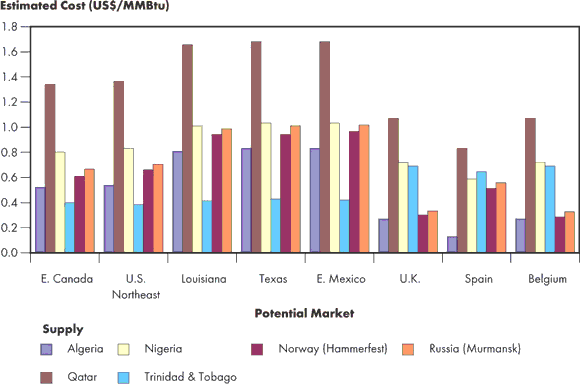
Source: NEB
These illustrative transportation costs suggest that for North American markets, the transportation cost is lowest to receive LNG supply from Trinidad and Tobago and that LNG import terminals on Canada's east coast may hold a slight transportation cost advantage over many of the other terminals in the U.S. and Mexico. LNG terminals on the east coast are also likely to serve natural gas markets in the northeast U.S. and eastern Canada, which historically have higher prices than in other market regions of North America.
In particular, LNG import terminals on Canada's east coast have targeted the New England market, which has historically relied on imports from LNG and pipeline volumes from Canada for a significant part of its gas supply. On an annual basis, New England consumes about 22 109m³ (800 Bcf) of natural gas, of which up to about 25 per cent is provided from LNG (Figure 4.3). The region also experiences pipeline constraints during peak demand periods, and additional supply from LNG, Canadian imports, or U.S. domestic production may be needed to support further environmental initiatives to reduce consumption of coal and oil products in the region.
Figure 4.3 - New England Natural Gas Consumption and LNG Imports
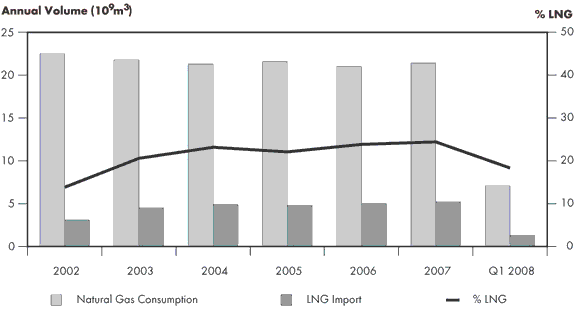
Source: EIA
Figure 4.2 also indicates that European markets would have a transportation cost advantage over Canadian terminals for LNG supply from regions other than Trinidad and Tobago. As a consequence, Canadian imports from other supply regions would typically only occur when prices in North America are sufficiently high to offset this difference, or, when European markets do not require all available LNG cargoes. In general, the transportation difference or hurdle to attract LNG supply is lower for terminals in the U.S. northeast and eastern Canada, particularly from northern supply sources. Canadian LNG terminals on the east coast have a transportation advantage for LNG supply from the Europe's North Sea, Russia and North Africa over other terminals in North America.
LNG receiving terminals in eastern Canada may face additional challenges associated with ensuring the interchangeability of regasified LNG and traditional gas supply without adversely impacting combustion and equipment operation. Traditionally, U.S. terminals in the northeast have predominately imported LNG supplies from Trinidad and Tobago which have composition and burning qualities similar to traditional pipeline gas in the region. LNG imports from other supply regions may also be accepted, but in some cases may have much different composition and characteristics and may require further processing to remove hydrocarbon liquids or conditioning to achieve similar burning qualities as typical pipeline gas. Appendix 4 illustrates the heat content of LNG from various supply regions of the world. Although heat content is only one indicator of gas quality and interchangeability, it serves to provide a perspective of the wide variability of LNG.
4.3 West Coast
Figure 4.4 illustrates the relative transportation costs to major market regions in the Asia-Pacific Basin from various supply regions. These estimates assume transportation using an average LNG carrier size and typical marine diesel costs observed in 2008.
Figure 4.4 - Illustrative Transportation Costs to Asia-Pacific Basin Markets

Source: NEB
As a potential market, LNG transportation costs to other Asia-Pacific Basin markets would usually be lower than to deliver to Canada's west coast and would not require the use of extensive additional pipelines to access major markets. While LNG transportation costs to Canadian terminals are generally lower than for other receiving terminals on the west coast of North America, most of the LNG supply in the Asia-Pacific region is much closer to the large LNG markets in East-Asia. Similarly, the cost to transport LNG from Peru to western Canada is second to other markets in Mexico. For these reasons, an LNG import terminal on Canada's west coast would likely serve as an alternative market when contracted supplies are not required elsewhere. Otherwise North American prices would need to be sufficiently high to offset the difference in transportation costs.
As a potential LNG supplier, an export terminal on Canada's west coast would benefit from having a relatively short distance and low shipping cost to markets in East-Asia and on the west coast of the U.S. and Mexico. From a transportation cost perspective, shipping costs from the west coast of Canada to Asian markets would be competitive with that from most other Asia-Pacific supply regions, with the exception of Russia. In addition, transportation costs from western Canada to terminals in Mexico would be competitive with those from other Asia-Pacific region supply.
A liquefaction and LNG export project on the west coast could provide natural gas producers in western Canada with access to incremental markets in Asia, with the potential to obtain much higher prices and returns than in North America in today's market. Although such a project may appeal to suppliers, there is significant uncertainty associated with the relative competitiveness with other LNG suppliers and the availability and cost of sufficient natural gas resources necessary to underpin a large long-term investment.
A recent increase in unconventional gas production in the U.S. may have created a more optimistic outlook for North American gas supply, but increases to date have mostly offset declines in conventional production and LNG imports. At this time, the full extent of shale gas development is unclear, particularly in western Canada where development is still in an early stage.
4.4 Canadian Issues and Uncertainty
The extent of incremental supply development in Canada and even in the U.S. is not certain. At this time, new natural gas development in Canada has not kept pace with the overall decline from traditional sources. In two of the three cases examined in the Board's recent report Short-term Canadian Natural Gas Deliverability 2008-2010, the Board suggested that Canadian production will continue on a downward trend as the result of lower gas-directed drilling and ongoing declines in initial well productivity.
To date, all of the proposed Canadian LNG import and regasification projects have included the ability to serve U.S. markets in addition to markets in Canada. For these projects, the larger U.S. market is an important anchor market to support development. Accordingly, Canadian LNG projects will also be subject to changes in supply and demand developments in the integrated North American natural gas market.
In general, Canadian projects are well located and should be competitive with other North American and global terminals. Eastern Canadian import terminals are located closer to a number of Atlantic Basin supply regions than most other Atlantic-based terminals in North America and are suitably located to serve the significant U.S. northeast market. However, LNG terminals serving this market may require additional processing or blending of LNG or may need to limit quantities from supply regions with significantly different gas composition from traditional gas supply to ensure seamless compatibility of LNG in end-use applications.
Potential Canadian import terminals on the west coast may be closer to some sources of Asia-Pacific LNG supply than other North American import terminals. However, west coast terminals in Canada may face additional hurdles and require greater use of connecting pipelines to access major markets.
The proposed LNG export terminal in western Canada is closer to Asian and other North American markets than many of the competing supply regions that serve the Asia-Pacific region. However, at this time, there is significant uncertainty on the extent of North American supply development and the ability to support both growing North American requirements and a long-term export market. Such a project, if approved and built, would enable further integration of North American and world natural gas markets.
Chapter 5 - Conclusions and Observations
The large amount of new regasification capacity being added in North America, Europe and East-Asia is likely to maintain a competitive market for global LNG supply. However, the amount of LNG required in each region is uncertain given the potential for greater development of other supply options such as natural gas pipeline imports to Europe and unconventional gas production in North America. Recent volatile energy prices and financial markets may have profound consequences for future LNG development and financing. Greater financial obligations on proponents could limit the participation of newer, less established developers who have been instrumental in a number of recent LNG projects in North America.
Although greater international trade of LNG may increase the availability of supply to North America, full globalization and price convergence in the LNG market by 2015 is not expected. LNG pricing in other major global markets are more closely indexed to the price of crude oil or oil products, whereas natural gas prices in North America are determined more by price competition between various sources of natural gas. The differences in pricing provide trading opportunities between regions and will affect the flow of LNG.
The North American market will continue to operate as a swing market for global LNG, utilizing its significant capacity for underground natural gas storage in order to import LNG during periods when natural gas demand is lower in other major markets. The extent to which North American LNG facilities are used and whether long-term supply is available will be determined largely by market conditions, by the stakeholders involved, their respective contractual arrangements for supply and markets, and the requirement for LNG in other global regions.
In the near term, lower economic growth in key consuming markets and lower and volatile energy prices will likely reduce the demand for natural gas and slow the rate of LNG development. In North America, growing production from shale and other unconventional gas resources have helped to offset the ongoing decline in conventional production and may reduce or set back the immediate requirement for LNG imports into North America. However, in the longer term, economic recovery and environmental initiatives to reduce the combustion of other fossil fuels and GHG emissions may result in significant demand for natural gas and LNG. The extent to which North America pursues the various alternate energy sources to natural gas will greatly influence the overall need for LNG.
Canadian LNG projects are well located and should be competitive with other North American projects for global markets and supply. As with other North American terminals, the utilization of Canadian facilities will be greatly dependent on market conditions and contracted LNG supply arrangements. Without dedicated long-term supply contracts, Canadian facilities are likely to serve as the alternate or swing market to other major LNG markets in Europe and Asia.
Glossary
| Coalbed methane | An unconventional form of natural gas that is trapped within the matrix of coal seams. |
| Henry Hub | A major natural gas hub and trading point in Louisiana and a common benchmark pricing point for North America. |
| Hydraulic fracture | A technique in which fluids are injected underground to create or expand existing fractures in the rock, allowing oil or gas to flow out of the formation or to flow at a faster rate. |
| Liquefaction | The process of cooling natural gas to a temperature of about -160 degrees Celsius, at which point it becomes a liquid or LNG. |
| National Balancing Point | A major natural gas trading point in the United Kingdom, used in this report to represent natural gas prices in continental Europe. |
| New England | A sub-region of the northeastern United States as defined by the U.S. Census Division. Consists of Connecticut, Maine, Massachusetts, New Hampshire, Rhode Island, and Vermont. |
| Regasification | The process of warming the LNG in order to return it to a gaseous state or natural gas. |
| Reserves | Reserves are estimated remaining marketable quantities of oil and natural gas and related substances anticipated to be recoverable from known accumulations, as of a given date, based on analysis of drilling, geological, geophysical and engineering data; the use of established technology; and specified economic conditions, which are generally accepted as being reasonable, and where applicable shall be disclosed. |
| Resources | The total volume of oil or natural gas that is thought to be found in an area, or that portion of the total resources that is not penetrated by a well bore to date, or the volume that could be found as a result of appreciation. |
| Shale gas | A form of unconventional gas where the gas molecules are mainly trapped on the organic material in a host rock of fine-grained shale. |
| Unconventional gas | Natural gas that is contained in a non-traditional reservoir rock that requires significant additional stimulus to allow gas flow. It may be that the gas is held by the matrix material such as coal, ice, or shale or where the reservoir has an unusually low amount of porosity and permeability. |
Appendix 1 - Global Region Definitions
Geographical regions used to characterize the various global natural gas markets in this report are defined purely for statistical purposes and convenience and do not intend to imply any political or economic standing. While the report attempts to stay consistent with regional definitions made by the United Nations Statistics Division, in many cases finer divisions or other commonly used country and geographical groupings are necessarily used to reflect the LNG industry and the data and analysis used in the production of this report.
Asia-Pacific: A general region encompassing East-Asia, South Asia, and Oceania and Southeast Asia as defined in this report.
Central Asia: Kazakhstan, Kyrgyzstan, Tajikistan, Turkmenistan and Uzbekistan.
Central & South America: Includes countries in Central America, South America and the Caribbean.
East-Asia: People's Republic of China (China), Hong Kong*, Macao*, Democratic People's Republic of Korea, Japan, Mongolia, Republic of China (Taiwan) and the Republic of Korea (South Korea).
Eurasia: Includes countries of continental Europe, Central Asia and the Republic of Turkey.
Middle East: Refers to countries in a region which includes the Arabian Peninsula, Mesopotamia, Persian Plateau, Anatolia and The Levant (Eastern Mediterranean).
North Africa: Considered as part of Africa in this report and would include LNG exporting countries Algeria, Egypt and Libya.
Oceania and Southeast Asia: Australia, New Zealand, Norfolk Island, Brunei Darussalam (Brunei), Cambodia, Indonesia, Lao People's Democratic Republic, Malaysia, Myanmar, Philippines, Singapore, Thailand, Timor-Leste and Vietnam.
North America: Canada, United States and Mexico.
Russia and the Former Soviet Union (Russia/FSU): Includes Russia and other independent nations that once formed the Union of Soviet Socialists Republic. Includes: Armenia, Azerbaijan, Belarus, Estonia, Georgia, Kazakhstan, Kyrgyzstan, Latvia, Lithuania, Moldova, Russia, Tajikistan, Turkmenistan, Ukraine and Uzbekistan.
South Asia: India, Pakistan and Bangladesh
* Special Administration Regions of China
Appendix 2 - Existing Global LNG Liquefaction Capacity
| Basin | Region | Capacity 109m³ per year |
Capacity mtpa |
Capacity Bcf/d |
|---|---|---|---|---|
| Existing LNG Liquefaction Terminals | ||||
| Atlantic | Americas | 20.6 | 15.1 | 2.0 |
| Europe | 5.6 | 4.1 | 0.5 | |
| Africa | 72.3 | 53.1 | 6.9 | |
| Middle East | Middle East | 64.3 | 47.2 | 6.1 |
| Asia-Pacific | Americas | 2.0 | 1.5 | 0.2 |
| Oceania | 106.3 | 78.1 | 10.1 | |
| Total | 23.8 | |||
| LNG Liquefaction Terminals Under Construction | ||||
| Atlantic | Africa | 13.2 | 9.7 | 1.3 |
| Middle East | Middle East | 72.8 | 53.6 | 6.9 |
| Asia-Pacific | Americas | 6.0 | 4.4 | 0.6 |
| Russia | 13.1 | 9.6 | 1.2 | |
| Oceania | 21.3 | 15.7 | 2.0 | |
| Total | 12.0 | |||
| Source: IEA | ||||
Appendix 3 - Current Global LNG Regasification Capacity
| Region | Capacity 109m³ per year |
Capacity Bcf/d |
LNG Storage m³ |
Underground Natural Gas Storage 109m³ |
|---|---|---|---|---|
| Existing Re-gasification Terminals | ||||
| North America | 109.8 | 10.5 | 2 973 720 | 117 |
| South & Central America | 7.9 | 0.8 | 320 000 | |
| Europe | 120.2 | 11.4 | 4 003 000 | 76 |
| Asia | 375.2 | 35.6 | 21 863 200 | 1.3 |
| Total | 58.2 | |||
| Re-gasification Terminals Under Construction | ||||
| North America | 71.4 | 6.8 | 2 240 000 | |
| South & Central America | 12.0 | 1.1 | 320 000 | |
| Europe | 75.6 | 7.2 | 3 008 500 | |
| Asia | 50.9 | 4.8 | 3 835 000 | |
| Total | 20.0 | |||
| Source: IEA | ||||
Appendix 4 - Illustrative Heat Content of Global LNG Supply
| Country | Heat Content (Btu per cubic foot) |
Supply Region |
|---|---|---|
| Libya | 1160 - 1190 | Atlantic |
| Brunei | 1133 - 1150 | Asia-Pacific |
| United Arab Emirates | 1127 - 1160 | Middle East |
| Oman | 1100 - 1160 | Middle East |
| Nigeria | 1110 - 1145 | Atlantic |
| Malaysia | 1120 - 1133 | Asia-Pacific |
| Indonesia | 1107 - 1118 | Asia-Pacific |
| Australia | 1065 - 1143 | Asia-Pacific |
| Qatar | 1024 - 1124 | Middle East |
| Algeria | 1041 - 1121 | Atlantic |
| Trinidad & Tobago | 1050 - 1082 | Atlantic |
| Equatorial Guinea | 1050 | Atlantic |
| USA (Alaska) | 1000 - 1030 | Asia-Pacific |
| Egypt | 1000 - 1041 | Atlantic |
| Norway | 1000 - 1075 | Atlantic |
Appendix 5 - The LNG Value Chain
The essence of the LNG value chain is not unlike that for conventional natural gas. It is based upon the monetization of natural gas assets with the main difference being that, because of the location of the assets, a more elaborate system is required to bring the commodity to end market. The basic elements of the LNG value chain are described below:
1. Exploration and Production
The exploration and production of natural gas used for LNG is essentially the same around the world, except that the gas exists in areas of the world with little or no domestic demand for the product. In general, it is produced by the same companies that produce natural gas in North America, using the same technology. Producing natural gas fields are connected by pipeline to liquefaction plants which then convert the natural gas to LNG.
2. Liquefaction
Natural gas becomes LNG when it is cooled to about -160°C (-260°F) at atmospheric pressure, through the use of refrigeration processes at the liquefaction plants. Liquefaction is the most unique portion of the LNG value chain when compared to the traditional natural gas value chain and requires the greatest amount of investment and use of sophisticated equipment and processes.
The large investment for liquefaction also requires large natural gas reserves to ensure the commercial viability of the project. In many countries, participation of government-owned companies is also common because of difficulties in receiving approvals and financing. Present day financing and supply contracts may also entail rigid requirements for guaranteed takes and payment.
3. Shipping
LNG is transported to various markets around the world via specialized shipping vessels that have onboard liquefaction units to keep the LNG cold and in its liquid form. LNG shipping costs can vary greatly depending on fuel costs, ship capacity and distance of haul. In general, LNG shipping becomes favourable compared to natural gas transportation via pipeline for transportation over large distances. LNG transportation can also provide suppliers with additional flexibility to serve a number of competing markets and facilitate arbitrage opportunities.
Market players may own their own ships or can charter or lease LNG vessels in order to avoid the large capital costs and specialized skills associated with building, owning and operating the ships. Historically, the LNG shipping fleet was owned by a few LNG players. As a result, transportation capacity was very limited and charter rates could make up the majority of the LNG transportation cost. In recent years, shipping costs have declined with the substantial growth in the LNG shipping fleet and advances in shipping technology.
4. Regasification
Upon reaching its destination, LNG is unloaded from the ship into the regasification terminal where the liquid commodity can be stored in tanks or transferred back into its gaseous state. Once regasified, LNG is natural gas and is handled the same as for any conventional natural gas. This includes any processing that may be required in order to achieve the gas quality standards of the regional pipelines and markets.
Regasification terminals are much less capital intensive relative to the investment required for liquefaction terminals and can be built easily without necessarily securing dedicated supply to ensure utilization at full capacity. In fact, having excess regasification capacity relative to supply will enable an LNG supplier to ensure high utilization of its liquefaction assets and may help to ensure the viability of that significant investment. Having regasification capacity to service different markets will also enable the LNG supplier to capitalize on arbitrage opportunities and obtain the highest return.
5. Markets
At this point, the natural gas can be delivered from the regasification terminal into the natural gas pipeline infrastructure of the region and used in the same way as conventional natural gas.
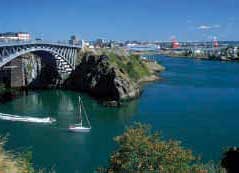

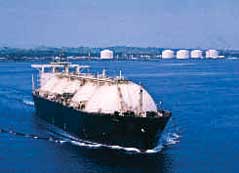
- Date modified:
